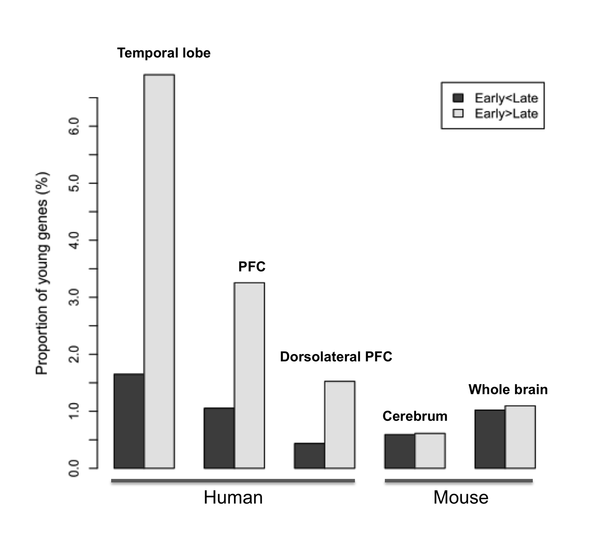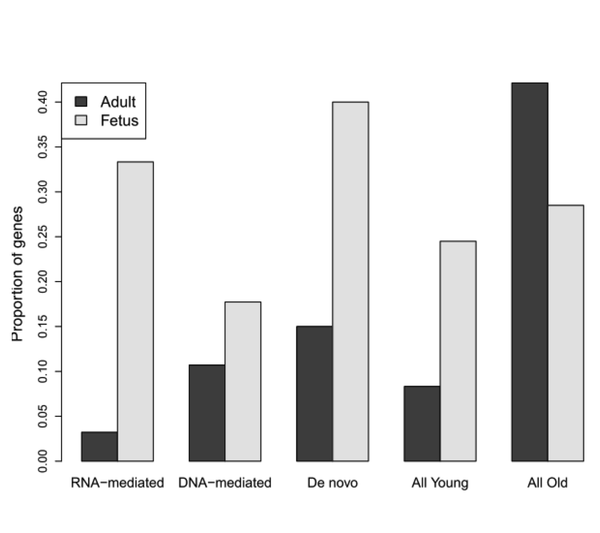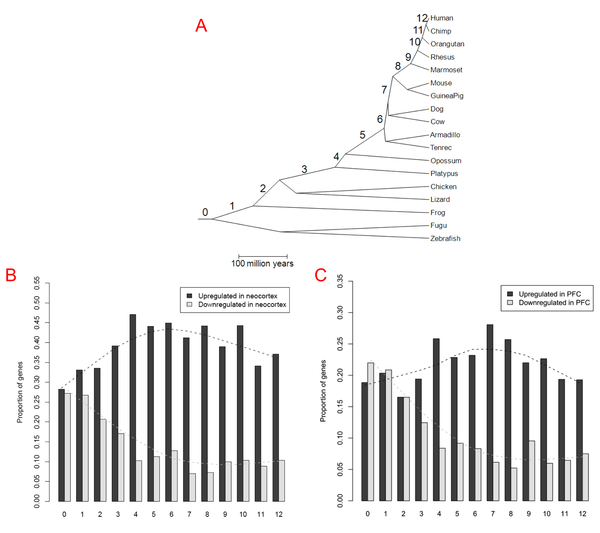The evolution of the human brain is the topic of a lot of research. This shouldn’t be surprising since it is so well-developed in human beings, and, as many believe, it is one of the main traits that sets us apart from our close evolutionary relatives. The seat of consciousness, culture, science, technology, and so on, exerts a great desire upon people to understand it, and to understand how it could have evolved. In order to study this question, a new study, published in PLoS Biology, investigated the occurrence and activity of evolutionary young genes in human brain development.
The researchers, from the University of Chicago, grouped their findings into four lines of evidence:
- Early brain development of human beings recruited excess new genes. Comparing human and mouse young genes, it was found that the human ones contribute a significantly larger proportion of all genes expressed in the early brain (see figure 1), while there is no difference between the expression of young genes in the adult brains of mice and man. The majority of these young genes in the human brain are upregulated in the neocortex.

Figure 1: Proportion of young genes expressed (PFC = Prefrontal cortex).
(Source: Zhang et al., 2011)
- Young genes in the fetal brain play a variety of roles. When determining functional classes of these young genes in the developing brain, many of them turned out to be transcriptional regulators, a larger proportion than in other young genes and old braind evelopment genes.
- Positive selection contributed to the evolution of these young early brain development genes. By taking a look at the position of these new genes in the genome, and the structure and homology of the genes, it was found that the genes originated through a variety of mechanisms (see figure 2). In the words of the authors:
In other words, young genes created by all major gene origination mechanisms tend to be upregulated in fetal brain. Such generality suggests that a systematic force instead of a mutational bias associated with a specific origination mechanism contributed to the excess of young genes in the fetal brain.

Figure 2: Proportion of genes upregulated in the young (grey) and adult (black) brain.
(Source: Zhang et al., 2011)
- Lastly, the excess of new genes recruited into the neocortex parallels its origination. The authors hypothesize:
If recruitment of new genes into the neocortex was at least partially driven by positive selection for functions in this brain structure, their ages should be correlated with the morphological evolution of neocortex itself. Thus, one prediction is that there would be no excessive recruitment of new genes into the neocortex before it originated.
When they compared the estimated dates of the origination of the young genes with phylogenetic trees (see figure 3), the data supports their hypothesis.

Figure 3: A) Phylogenetic tree of vertebrates. B) Proportion of genes differentially expressed in the neocortex, compared to non-neocortical regions and C) Proportion of genes differentially expressed in PFC, compared to non-neocortical regions.
(Source: Zhang et al., 2011)
Overall, the conclusion is that:
These four lines of evidence suggest that positive selection for brain function may have contributed to the origination of young genes expressed in the developing brain. These data demonstrate a strikingrecruitment of new genes into the early development of the human brain.
Reference
Zhang, Y.E.; Landback, P.; Vibranovski, M.D. and Long,M. (2011). Accelerated Recruitment of New Brain Development Genes into the Human Genome. PLoS Biology 9(10): e1001179. doi:10.1371/journal.pbio.1001179.(Click here for the article.)



Comments